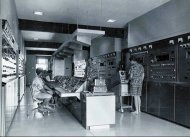“Television came to American Samoa on Sunday afternoon, October 4, 1964.” Thus opens a 1981 book by mass communications scholar William Schramm and his colleagues, Bold Experiment: The Story of Educational Television in American Society. Although there were other instructional television initiatives ongoing around the world, its introduction in American Samoa “was the first time a developing region set out to use that medium in an all-out attempt to modernize an educational system.”
“Samoan children are learning twice as fast as they once did, and retaining what they learn. Surely from among them, one day, will come scientists and writers to give their talents to Samoa, to America, and to the world.”
 But in the following years, there grew a substantial resistance and resentment to this centralized system of televised instruction – from teachers and from students, particularly at the high school level. (Perhaps there had been earlier too, but data on teachers’ and students’ attitudes, as well as on students’ educational attainment was not tracked in the initiative’s early years.) By 1979, Schramm reports, the broadcasts had been radically trimmed – from a studio system that produced 6000 educational programs a year to one that produced just one series. Instead of supplanting teachers, “television’s classroom role had been largely reduced to that of a supplemental or enrichment service, to be used when and if a teacher decided it was appropriate.”
But in the following years, there grew a substantial resistance and resentment to this centralized system of televised instruction – from teachers and from students, particularly at the high school level. (Perhaps there had been earlier too, but data on teachers’ and students’ attitudes, as well as on students’ educational attainment was not tracked in the initiative’s early years.) By 1979, Schramm reports, the broadcasts had been radically trimmed – from a studio system that produced 6000 educational programs a year to one that produced just one series. Instead of supplanting teachers, “television’s classroom role had been largely reduced to that of a supplemental or enrichment service, to be used when and if a teacher decided it was appropriate.”
Television didn’t go away, of course. But the transmissions became commercial – carrying NBC (and some PBS) programming. (The two most popular shows in American Samoa in 1976: Police Woman and Sanford & Son.)









